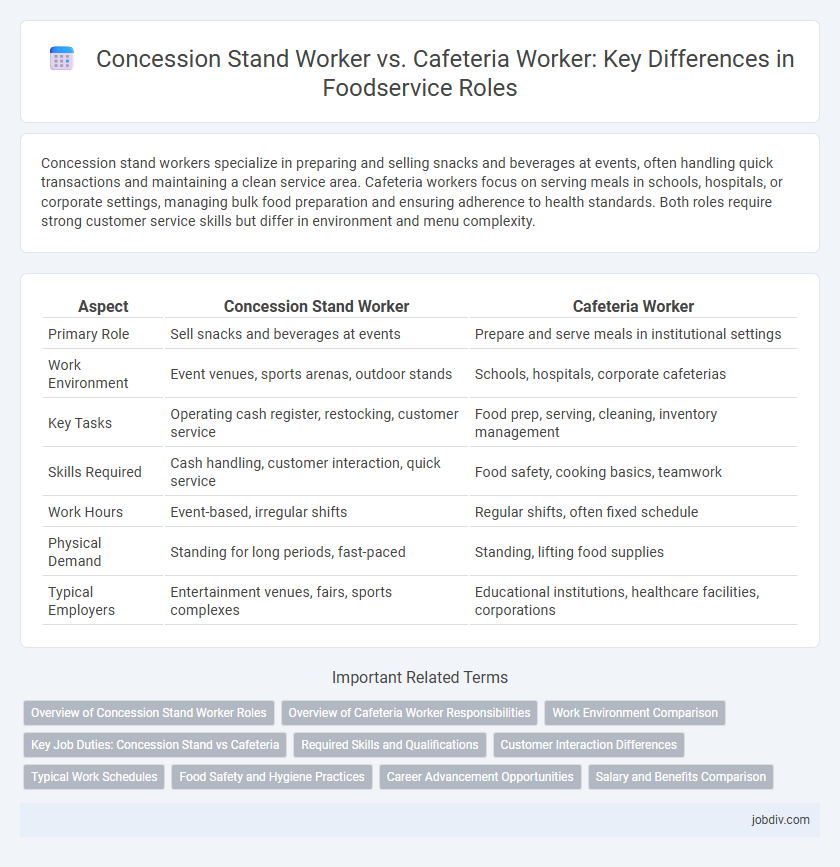Concession stand workers specialize in preparing and selling snacks and beverages at events, often handling quick transactions and maintaining a clean service area. Cafeteria workers focus on serving meals in schools, hospitals, or corporate settings, managing bulk food preparation and ensuring adherence to health standards. Both roles require strong customer service skills but differ in environment and menu complexity.
Table of Comparison
| Aspect | Concession Stand Worker | Cafeteria Worker |
|---|---|---|
| Primary Role | Sell snacks and beverages at events | Prepare and serve meals in institutional settings |
| Work Environment | Event venues, sports arenas, outdoor stands | Schools, hospitals, corporate cafeterias |
| Key Tasks | Operating cash register, restocking, customer service | Food prep, serving, cleaning, inventory management |
| Skills Required | Cash handling, customer interaction, quick service | Food safety, cooking basics, teamwork |
| Work Hours | Event-based, irregular shifts | Regular shifts, often fixed schedule |
| Physical Demand | Standing for long periods, fast-paced | Standing, lifting food supplies |
| Typical Employers | Entertainment venues, fairs, sports complexes | Educational institutions, healthcare facilities, corporations |
Overview of Concession Stand Worker Roles
Concession stand workers primarily manage fast-paced food service operations at entertainment venues such as stadiums, theaters, and fairs, focusing on quick order processing and customer interaction. Their responsibilities include preparing and serving snacks, handling cash transactions, maintaining food safety standards, and restocking inventory efficiently. Unlike cafeteria workers who often serve meals in educational or institutional settings, concession stand workers emphasize speed and multitasking to accommodate large crowds during peak event times.
Overview of Cafeteria Worker Responsibilities
Cafeteria workers prepare and serve food, maintain cleanliness, and ensure compliance with health and safety regulations in institutional settings such as schools, hospitals, and corporate cafeterias. Their responsibilities include managing food inventory, assisting customers with menu selections, and operating kitchen equipment efficiently. Unlike concession stand workers who primarily handle quick-service snacks at venues, cafeteria workers handle a broader range of meals in more structured dining environments.
Work Environment Comparison
Concession stand workers typically operate in fast-paced, seasonal environments such as sports arenas or event venues, often working evenings and weekends with limited indoor space. Cafeteria workers are more likely to work in stable, institutional settings like schools or corporate dining areas, providing consistent daily hours in a controlled, indoor environment. Both roles require teamwork and customer service skills but differ significantly in physical layout and work schedule consistency.
Key Job Duties: Concession Stand vs Cafeteria
Concession stand workers primarily handle cash transactions, prepare and serve snacks, and maintain cleanliness in compact, high-traffic environments like sports venues or cinemas. Cafeteria workers focus on food preparation, portioning meals, and serving a wider variety of hot and cold items in institutional settings such as schools or hospitals. Both roles prioritize customer service and sanitation, but concession stands emphasize speed and efficiency, while cafeteria workers ensure balanced meal offerings and nutritional standards.
Required Skills and Qualifications
Concession stand workers require strong customer service skills, multitasking ability, and basic food safety knowledge to efficiently handle fast-paced environments. Cafeteria workers must possess food preparation expertise, sanitation certification, and teamwork capabilities to maintain smooth daily meal operations. Both roles demand attention to detail and adherence to health regulations to ensure safe food handling.
Customer Interaction Differences
Concession stand workers typically engage in fast-paced, high-volume customer interactions, focusing on quick service and transactional efficiency during events, while cafeteria workers manage a steady flow of customers with more personalized and sustained communication throughout meal periods. Concession stand roles demand skill in handling cash swiftly and managing peak-time pressure, whereas cafeteria workers often assist with menu explanations and dietary accommodations, fostering a more interactive customer experience. Both roles require strong interpersonal skills but differ in the depth and pace of customer engagement within the foodservice environment.
Typical Work Schedules
Concession stand workers often have irregular schedules, working primarily during events, evenings, weekends, and holidays to accommodate high customer traffic. Cafeteria workers generally maintain more consistent, daytime hours aligned with school or business meal times, typically operating Monday through Friday. Both roles require flexibility but differ substantially in the predictability and frequency of work shifts.
Food Safety and Hygiene Practices
Concession stand workers must adhere to strict food safety guidelines by regularly sanitizing surfaces and maintaining proper temperature control to prevent contamination during high-traffic events. Cafeteria workers follow rigorous hygiene protocols such as frequent handwashing and correct food storage techniques to ensure a safe dining environment for students and staff. Both roles require compliance with local health department regulations and effective use of personal protective equipment to minimize the risk of foodborne illnesses.
Career Advancement Opportunities
Concession stand workers often gain valuable experience in fast-paced, customer-facing environments that can lead to roles in foodservice management or event coordination. Cafeteria workers typically develop skills in food preparation and kitchen operations, offering pathways to supervisory positions or culinary arts careers within institutional settings. Both roles provide foundational experience, but cafeteria work tends to offer more structured career advancement within educational or healthcare foodservice systems.
Salary and Benefits Comparison
Concession stand workers typically earn an hourly wage ranging from $9 to $13, often with limited benefits due to part-time or seasonal employment. Cafeteria workers usually receive a slightly higher hourly rate between $11 and $15, alongside access to benefits such as health insurance, retirement plans, and paid leave, reflecting their more stable, full-time positions. Salary differences also stem from the varying responsibilities and work environments in foodservice settings, impacting overall compensation packages.
Concession Stand Worker vs Cafeteria Worker Infographic

 jobdiv.com
jobdiv.com